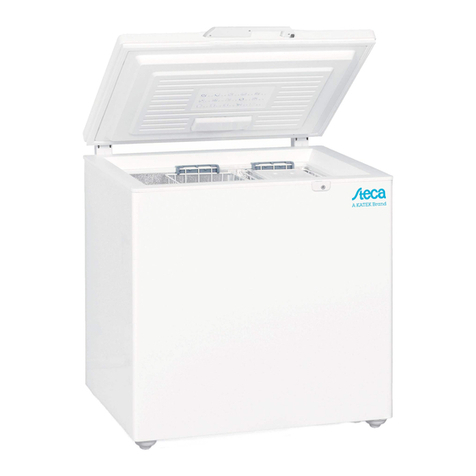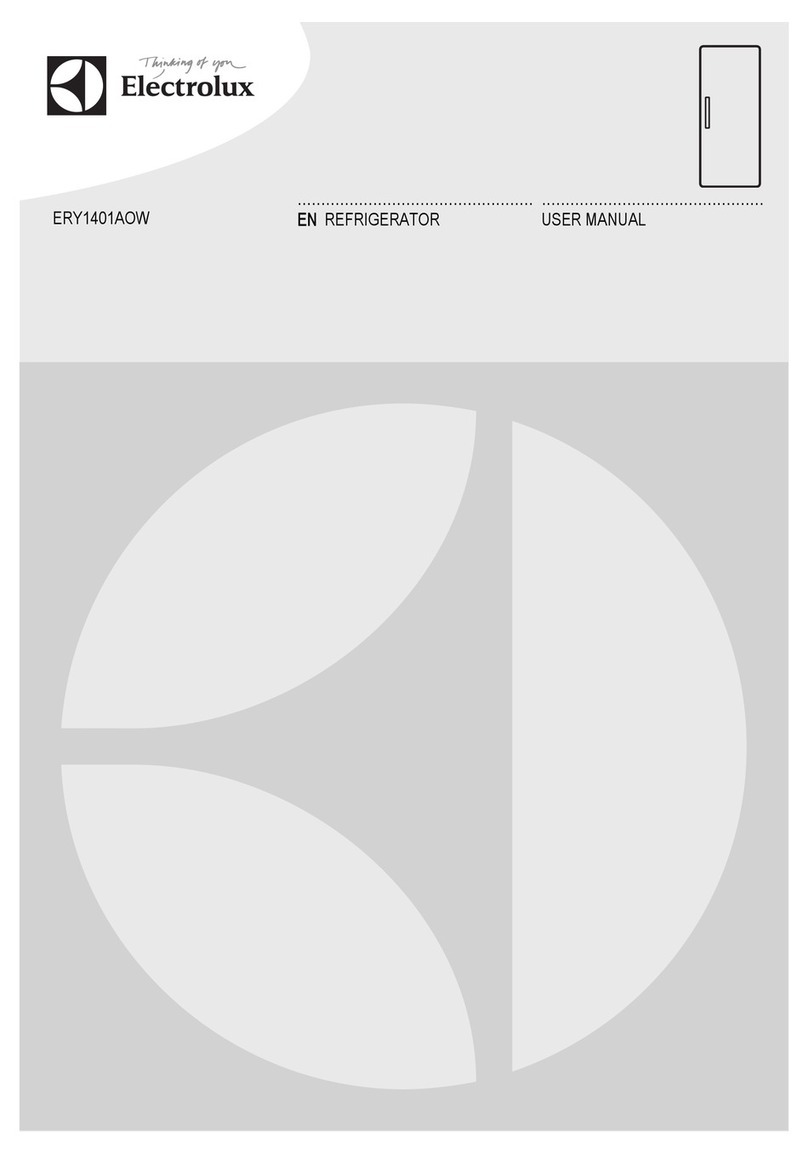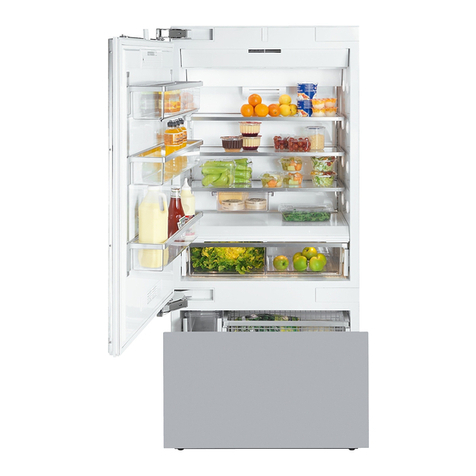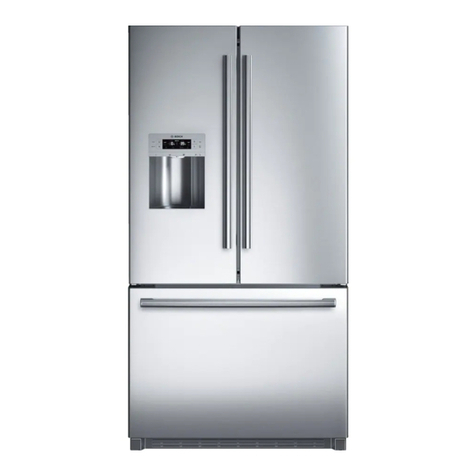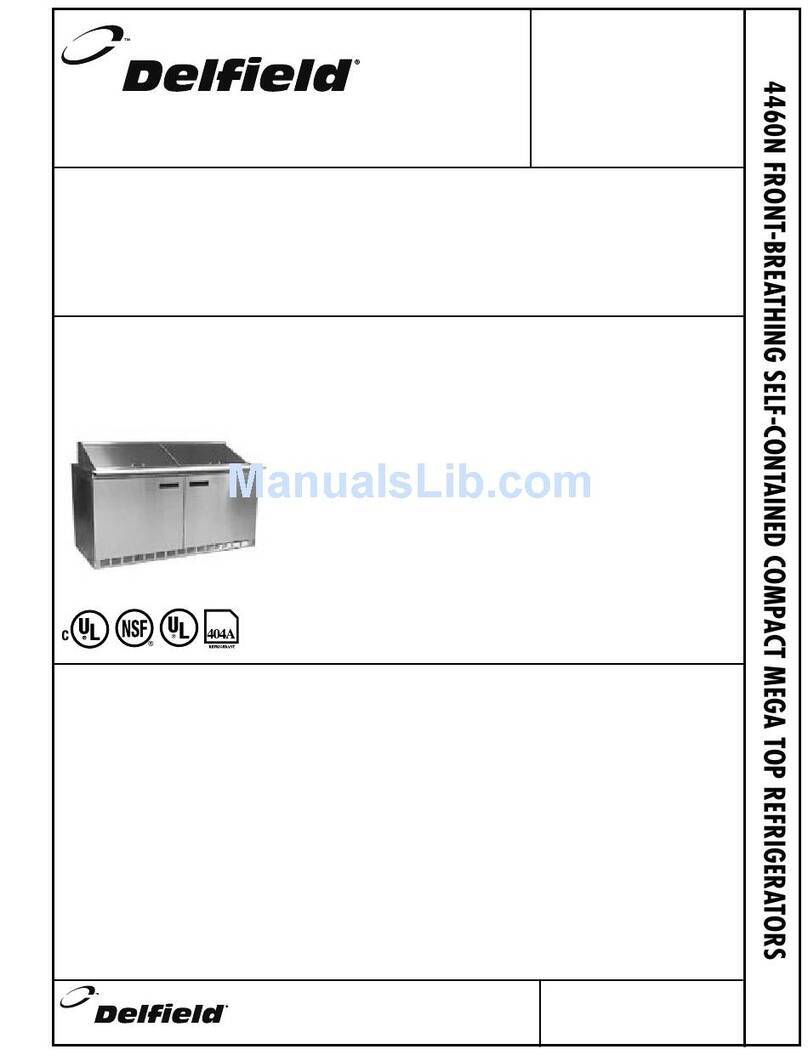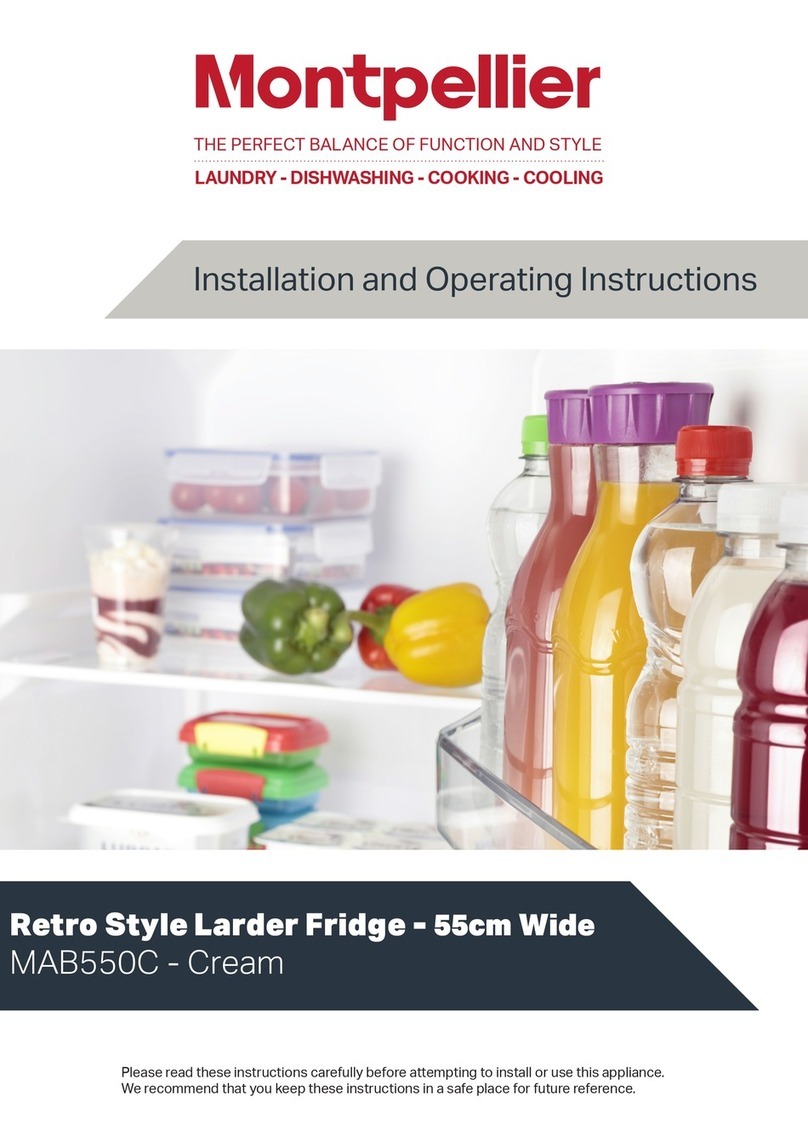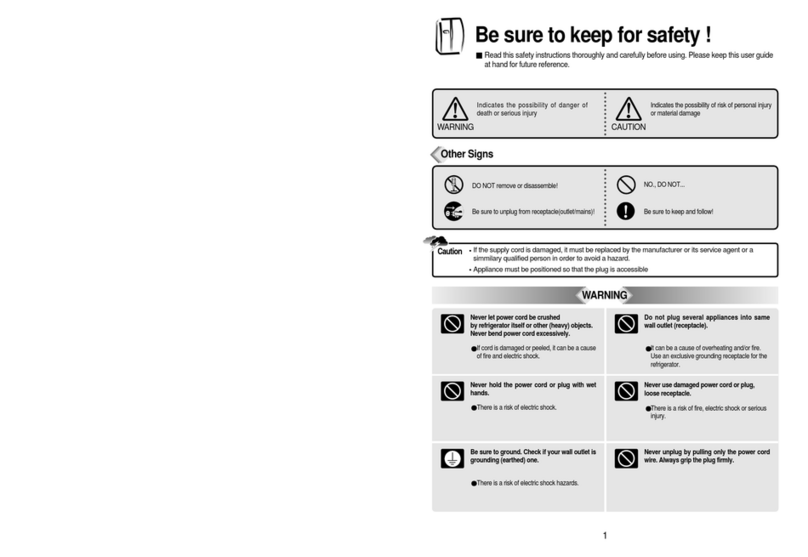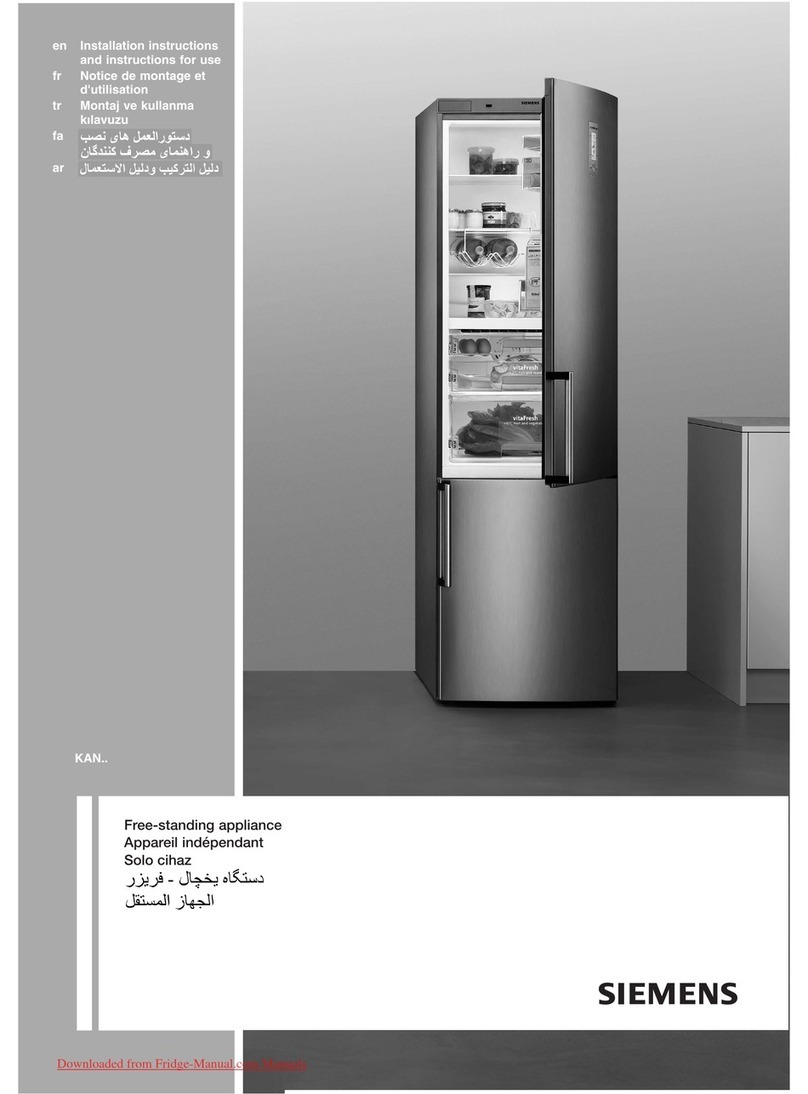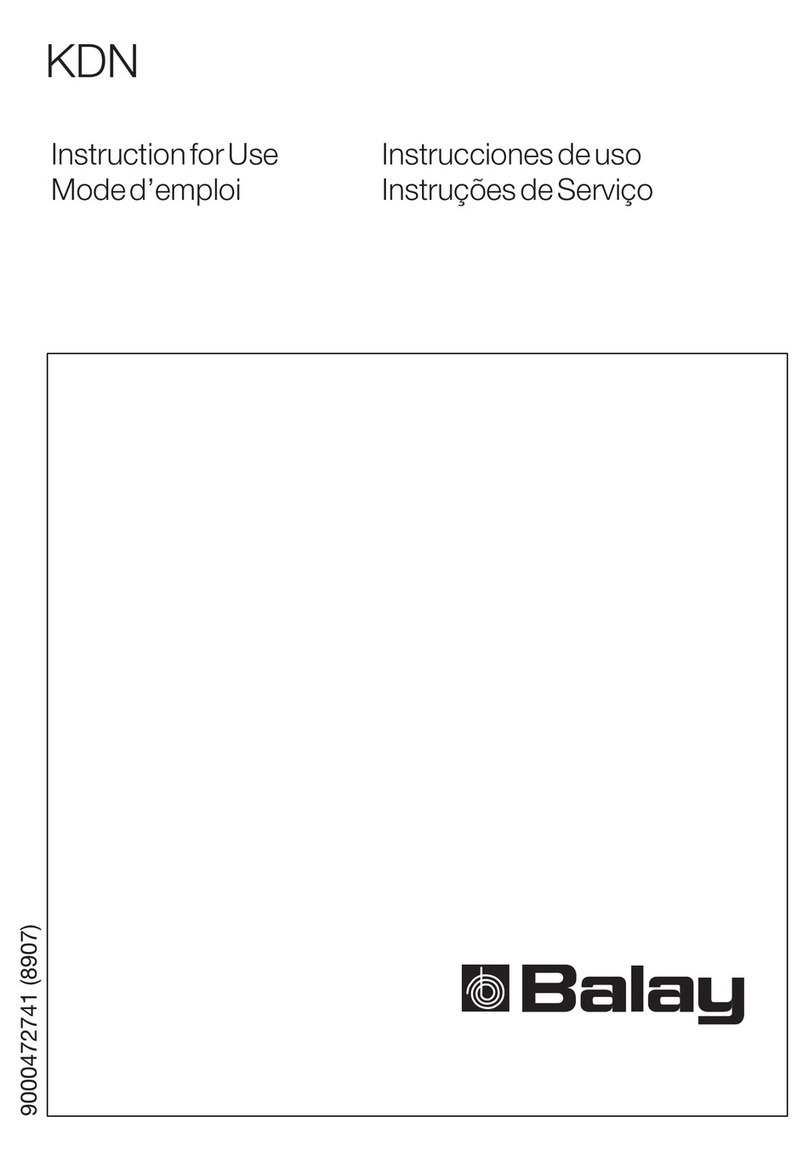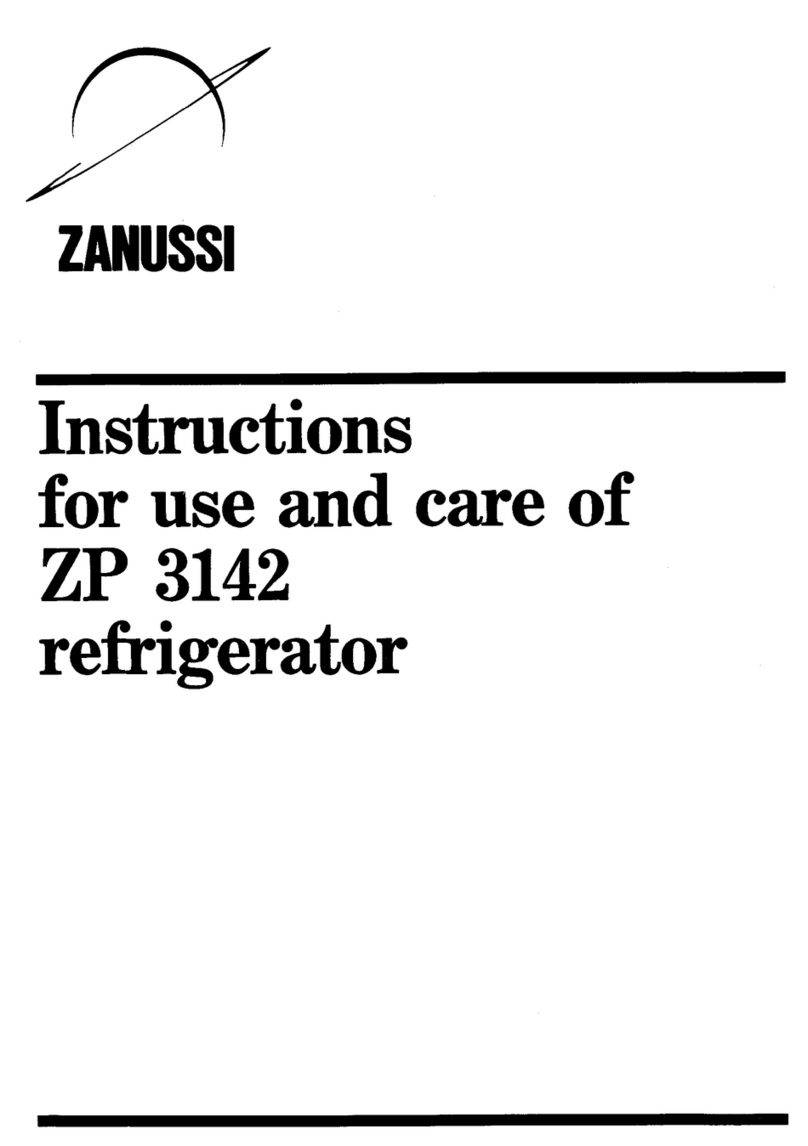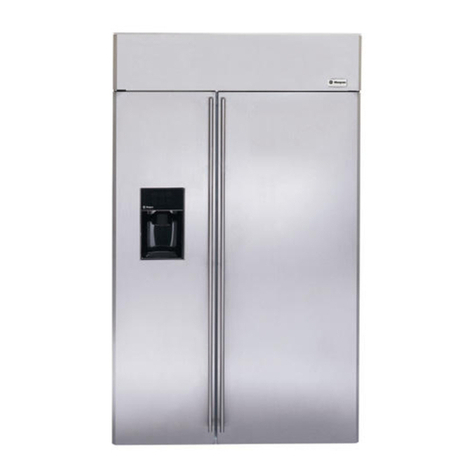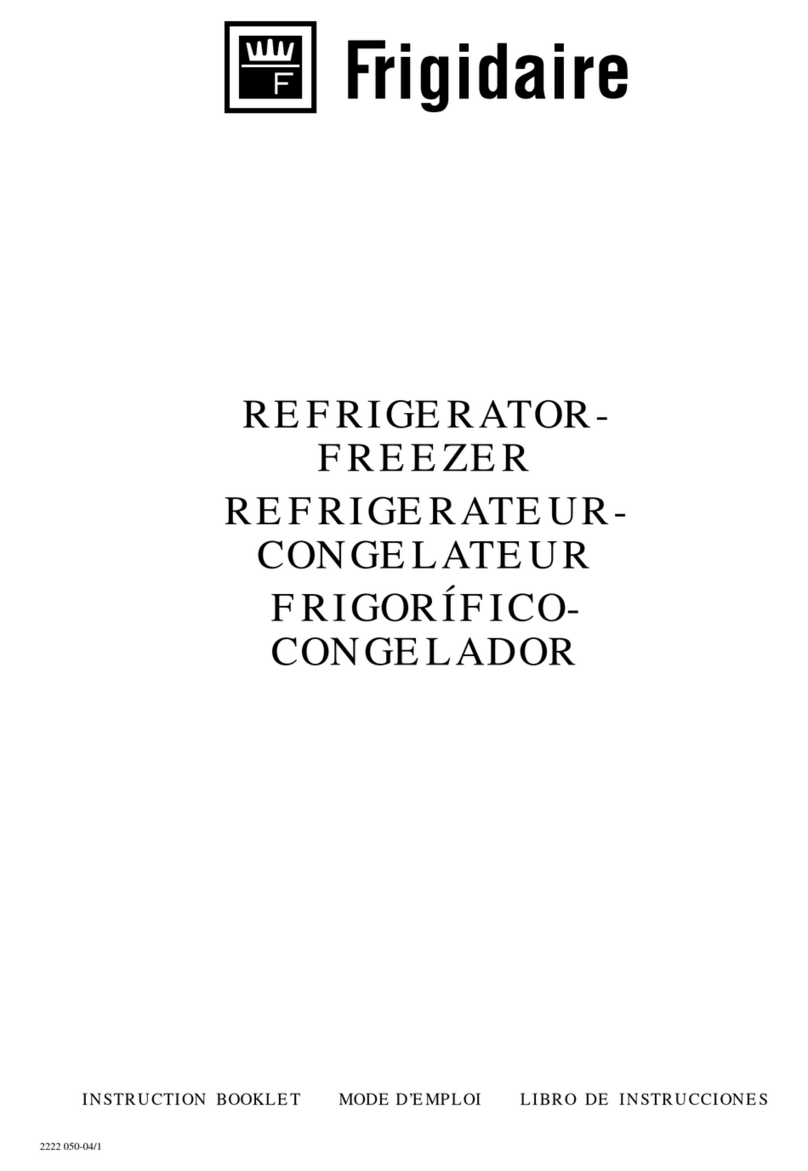Steca PF166 User manual

722.649 | Z02 | 07.51
PHOTOVOLTAIK - PHOTOVOLTAICS - PHOTOVOLTAIQUE - FOTOVOLTAICA
EN
Installation and operating instructions
Steca PF166 refrigerator / freezer
for 12 / 24 V DC

2722.649 | 07.51
ENGLISH
Contens
1 About this manual ....................................................................................3
1.1 Applicability......................................................................................... 3
1.2 Users.................................................................................................... 3
1.3 Description of symbols......................................................................... 3
2 Safety ........................................................................................................4
2.1 Dangers during installation and commissioning .................................. 4
2.2 Exclusion of liability ............................................................................. 4
3 Disposal instructions.................................................................................5
4 Device and features overview...................................................................5
5 Installation ................................................................................................6
6 Connection................................................................................................6
6.1 Direct connection to the battery .......................................................... 7
6.2 Connection to a charge controller with deep discharge protection ..... 7
7 Operating the device ................................................................................7
7.1 Switching the device on / off ............................................................... 7
7.2 Setting the temperature ...................................................................... 7
7.3 Temperature alarm............................................................................... 8
8 Menu functions.........................................................................................8
8.1 Setting the brightness.......................................................................... 8
8.2 Setting the display of Celsius / Fahrenheit............................................ 8
8.3 Setting refrigerator / freezer mode ...................................................... 8
9 Power outage display ..............................................................................9
10 Notes on freezing and storage .................................................................9
11 Features...................................................................................................10
11.1 Baskets............................................................................................... 10
11.2 Lock ................................................................................................... 10
11.3 Freezer tray (depending on features) ................................................. 10
11.4 Cold battery (depending on features) ................................................ 10
12 StopFrost system ....................................................................................10
13 Defrosting ...............................................................................................10
14 Cleaning ..................................................................................................11
15 Faults.......................................................................................................12
16 Decommissioning ...................................................................................12
17 Technical data .........................................................................................13

3
722.649 | 07.51
ENGLISH
1 About this manual
1.1 Applicability
This manual describes the installation, commissioning, function, operation,
maintenance and deinstallation of the refrigerator / freezer.
When installing the remaining components, e.g. the photovoltaic modules, the
cabling, and other accessories, be sure to observe the appropriate installation
instructions provided by each manufacturer.
1.2 Users
Installation, commissioning, maintenance and deinstallation of the refrigerator /
freezer may only be done by trained personnel in accordance with the applicable
on-site installation regulations. The professional personnel must be familiar with this
operating manual and follow the instructions contained herein.
1.3 Description of symbols
1.3.1 The structure of the warning notices
SIGNAL WORD
Type, source and consequences of the danger!
Measures for avoiding danger
1.3.2 Danger levels in warning notices
Danger level Probability of occurrence Consequences resulting from
non-compliance
DANGER imminent threat of danger death, serious bodily injury
WARNING possible threat of danger death, serious bodily injury
CAUTION possible threat of danger minor bodily injury
CAUTION possible threat of danger property damage
1.3.3 Notes
NOTE
Note on easier and safer working habits.
Measures for easier and safer working habits
1.3.4 Other symbols and markings
Symbol Meaning
call to action
result of action
- action description
• list
Emphasis on
issue at hand
emphasis on issue at hand
Pictogram with corresponding warning
symbol

4722.649 | 07.51
ENGLISH
2 Safety
2.1 Dangers during installation and commissioning
The following dangers exist during installation / commissioning of the refrigerator
/ freezer and during operation (in case of installation errors):
To avoid personal and material damage, the device should be unpacked and
installed by two people.
If the device is damaged, contact the supplier immediately - before connection.
To ensure safe operation, only install and connect the device according to the
information in the operating instructions.
If a fault occurs, immediately remove power from the device. Remove the fuse
and disconnect the battery or pull the power plug.
Only allow trained personnel to perform repairs and other internal work on the
device, otherwise this may result in significant danger for the users.
Do not bring open flames or other ignition sources into the internal spaces of the
device. Ensure that the cooling circuit is not damaged when transporting and
cleaning the device. In case of damage, keep ignition sources away and ventilate
the room well.
This device is not intended for persons (or children) with physical, sensory, or
mental disabilities, or who have inadequate experience and knowledge, unless
they are instructed in the use of the device, or initially supervised, by a person
responsible for their safety. Children should not be left alone with the device, to
ensure that they do not play with it.
Avoid long-term skin contact with cold surfaces or cooled / frozen products. This
can lead to pain, numbness and freezing. Wear protective clothing, e.g. gloves,
when longer skin contact is unavoidable.
Do not immediately consume ice cream, especially frozen drinks and ice cubes,
after removal or while they are still too cold. The low temperatures can present a
"burn danger".
Do not consume food that has been stored for too long, it can lead to food
poisoning.
The device is intended for cooling and freezing food and for the preparation of
ice products. It is conceived for household use. The applicable commercial regula-
tions must be observed when the device is used in a commercial environment.
For lockable devices, do not store the key near to the device or within the reach
of children.
Do not store explosive substances or spray cans with inflammable materials, such
as propane, butane, pentane etc., in the device. Escaping gases can be ignited by
electrical components. These types of spray can be recognized by the contents
printed on the can or by a flame symbol.
Do not use electrical equipment within the device.
2.2 Exclusion of liability
The manufacturer cannot monitor the compliance to this manual as well as the
conditions and methods during the installation, operation, usage and mainte-
nance of the refrigerator / freezer. Improper installation of the system may result in
damage to property and, as a result, in bodily injury.
Therefore, we assume no responsibility and liability for loss, damage or costs
which result or are in any way related to incorrect installation, improper operation
and incorrect use and maintenance.
Similarly, we assume no responsibility for patent right or other right infringements
of third parties caused by usage of this refrigerator / freezer.
The manufacturer reserves the right to make changes to the product, technical
data or assembly and operating instructions without prior notice.
As soon as it becomes evident that safe operation is no longer possible (e.g.
if there is visible damage), remove the device from the power supply im-
mediately.
•
•
•
•
•
•
•
•
•
•
•
•
•
•

5
722.649 | 07.51
ENGLISH
3 Disposal instructions
The packaging is made from recyclable materials.
Corrugated cardboard / Cardboard
Moulded polystyrene parts
Polyethylene plastic
Polypropylene reinforcing straps
WARNING
Packaging material is not a toy for children - danger of suffocation from
plastic!
Bring the packaging to an official recycling centre.
The worn out device:
The device still contains valuable materials and is not to be disposed of in the
normal household waste.
Render worn out devices unusable. Pull the power plug, cut the power cable
and make the lock unusable to prevent children from locking themselves
inside.
Ensure that the cooling circuit of the worn out device is not damaged when
being transported.
Information on the coolant used is on the type plate.
Worn out devices must be professionally disposed of in accordance with local
regulations and legislation.
4 Device and features overview
Temperature adjustment button
On / Off button
Alarm off button
Temperature display °C
Temperature display °F
Menu button for configuration
Digital temperature display
Minus display
NOTE
Be sure to close the condensation-water outflow opening in the base of the
device!
Be sure to close the condensation-water outflow opening in the base of the
device using the plugs provided before commissioning the device! This is
important for proper functioning of the device.
•
•
•
•
•
•
•
•
➊
➋
➌
➍
➎
➏
➐
Operating and
monitoring ele-
ment
Type plate
Lock
Motor space
ventilation grill
Condensation
water outflow
➑
°C
Menu
°F
➊
➊
➋
➌
➏➍➑
➎➐

6722.649 | 07.51
ENGLISH
5 Installation
Avoid installation locations in direct sunlight, or next to stoves, heating, or
similar heat sources.
The floor at the installation location should be level and flat. Install the device
a sufficient distance from the wall so that the lid can open and close unhin-
dered.
Do not cover the gap between the lower edge of the cabinet and the floor,
because the chiller must be provided with cooling air.
The minimum clearance between the ventilation grill and the wall is 20 cm.
This clearance must always be maintained and the ventilation grill must not
be covered.
Do not alter the outer cladding of the device. A minimum all-round clearance
of 20 mm must be maintained to ensure adequate heat dissipation.
According to the EN 378 standard, the installation room for the device must
have a volume of 1 m³ per 8 g of R 600a coolant, so that if a leak develops in
the cooling circuit no inflammable gas-air mixture can result in the installation
room. Information on the coolant volume can be found on the type plate.
Do not connect the device together with other devices using an extension
cable - danger of overheating.
Take note of the cable cross-section information in the table below when extend-
ing the power cable.
6 Connection
The power type and voltage at the installation location must match the specifi-
cations on the type plate. The type plate is located on the upper right side wall
of the cabinet.
WARNING
Risk of electrical shock and fire when connected to a voltage supply outside
the specified range.
The cable provided must be connected to a 12 V or 24 V DC connection at the
battery or the charge controller.
Please pay attention to the correct polarity: blue (-) and red (+).
NOTE
Energy saving
Avoid long and unnecessary opening of the lid.
Allow warm food to first cool to room temperature before storing it in the
device.
Defrost the device when an ice layer has formed. This improves the cooling
transfer and reduces the energy consumption.
•
•
•
•
•
•
•
•
Cable sizes 12 V
Cable length
24 V
Cable length
Cross-section AWG
mm² Gauge m ft. m ft.
2.5 12 2.5 8 5 16
412 4 13 8 26
610 6 19.5 12 39

7
722.649 | 07.51
ENGLISH
6.1 Direct connection to the battery
CAUTION
The device does not function
Please pay attention to the correct polarity!
The compressor is switched off by the integrated deep discharge protection, but
the control unit remains in operation. The alarm sounds when the temperature
increases (see chapter 7.3).
NOTE
Connection to the battery
Select this type of connection when you wish to give your device a high priority
in the solar energy system, e.g. when you wish to cool / freeze critical prod-
ucts.
6.2 Connection to a charge controller with deep
discharge protection
CAUTION
The device does not function
Please pay attention to the correct polarity!
If the deep discharge protection of the charge controller completely switches off
the cabinet power, then the control unit also receives no power. When the device
is switched on again automatically, the integrated power outage display (see
chapter 9) informs you of the internal temperature reached.
NOTE
Connection to a charge controller
Select this type of connection when you wish to give your device the same
priority as other loads in the solar energy system, e.g. when you wish to cool /
freeze non-critical products.
7 Operating the device
7.1 Switching the device on / off
The device can be manually switched on or off using the ➋button (On / Off).
If the cabinet is switched off, the minus symbol ➑ flashes to indicate that the
cabinet is still connected to the power.
When the device is connected for the first time, it must be manually switched on
by pressing the ➋button (On / Off).
On delivery, the device is set to cool (8 °C | 46.4 °F).
7.2 Setting the temperature
The standard internal temperature for normal operation is +8 °C | 46.4 °F. This
value can be changed in the following manner.
The desired internal temperature is set by pressing the ➊buttons (Up /
Down). Pressing a button once causes the display to begin flashing.
If the ➊button is pressed again while the display is flashing, each button
press increases / reduces the value by 1 °C.
If no button is pressed within a period of 5 seconds, the currently set value is
adopted as the actual temperature.
NOTE
Adjustable temperature range
In refrigerator mode, temperatures from +2 °C (36 °F) to +12 °C (54 °F) can
be set, and in freezer mode, temperatures from -10 °C (14 °F) to -20 °C (-4 °F)
can be set.
•
•

8722.649 | 07.51
ENGLISH
7.3 Temperature alarm
The temperature alarm helps to protect your cooled / frozen products and also
helps to save energy.
The alarm sounds when the internal space is not cold enough. The temperature
display flashes at the same time, or when too much warm air enters the cabinet
while sorting, placing, or removing food.
Pressing the "ALARM" button mutes the alarm. The temperature display contin-
ues to flash until the alarm state is over.
8 Menu functions
The following functions can be set using the menu:
The display brightness
Temperature display in degrees Celsius or Fahrenheit
The use of the device as a refrigerator or freezer
8.1 Setting the brightness
Pressing the ➏button (Menu) for 3 seconds brings you to the menu, the ➎
display (°F symbol) flashes and "b" is displayed.
Pressing the ➏button (Menu) again causes a "1" to appear in the display.
The ➊buttons (Up / Down) allow a brightness value of 1, 2 or 3 to be
selected. The higher the number, the brighter the display.
Once the desired brightness has been set, this has to be confirmed by
pressing the ➏button (Menu).
Pressing the ➋button (On / Off) returns you to the standard mode.
NOTE
Energy saving
The higher the brightness, the higher the power consumption.The factory setting
b1 is the power-saving mode.
8.2 Setting the display of Celsius / Fahrenheit
Pressing the ➏button (Menu) for 3 seconds brings you to the menu, the ➎
display (°F symbol) flashes and "b" is displayed.
Pressing the ➊button (Up) allows you to change from "b" to .
If you now press the ➏button (Menu) then °C appears.
The ➊buttons (Up / Down) can now be used to select between °C and °F.
Once the desired value has been set, this is confirmed by pressing the ➏
button (Menu).
Pressing the ➋button (On / Off) returns you to the standard mode.
8.3 Setting refrigerator / freezer mode
Pressing the ➏button (Menu) for 3 seconds brings you to the menu, dis-
play 5 (°F symbol) flashes.
Pressing the ➊button (Up) causes to appear.
Pressing the ➊button again causes F to appear.
Pressing the ➏button (Menu) again causes F to display.
The ➊buttons (Up / Down) can now be used to select between refrigerator
F and freezer F .
Once the desired value has been set, this is confirmed by pressing the ➏
button (Menu).
Pressing the ➋button (On / Off) returns you to the standard mode.
•
•
•
11
22
33
44
11
22
33
44
55
11
22
33
44
55
66
Refrigerator Freezer

9
722.649 | 07.51
ENGLISH
9 Power outage display
If PS is shown in the display, this means that: A power interruption in the last
hours or days has resulted in a temperature increase within the device. This can
occur as a result of (e.g.) deep discharge protection (charge controller).
If you press the "Alarm" button while PS is displayed, then the display shows the
highest temperature reached during the power outage. Depending on the level
of warming or thawing, you should check the quality of the food and decide
whether it can still be used, even when the cabinet has returned to the set tem-
perature long after the power outage!
This highest temperature is displayed for about one minute. The electronics then
display the actual cooling / freezing temperature once more.
10 Notes on freezing and storage
Store the same types of cooled / frozen products together.
The following products are suitable for freezing: meat, game, poultry,
fresh fish, vegetables, fruit, dairy products, bread, cakes and pastries, conven-
ience food.
The following products are not suitable for freezing: Cabbage or lettuce,
radishes, grapes, whole apples and pears, fatty meat.
Always pack food that you freeze yourself in household-sized portions. To
ensure that the products quickly freeze to the core, the following quantities
per package should not be exceeded: Fruit and vegetables up to 1 kg, meat
up to 2.5 kg.
Blanch vegetables after washing and portioning (place in boiling water for
2-3 minutes, then remove and rapidly cool in cold water).
Do not salt or season fresh food and blanched vegetables before freezing.
Other food should only be lightly salt and seasoned. Seasoning changes the
taste intensity.
Commonly available freezer bags and reusable plastic, metal, and aluminium
containers can be used for packaging.
Do not allow unfrozen food to come into contact with already frozen food.
Always store dry packages to ensure that they do not freeze together.
Always label the packaging with date and contents and never exceed the
recommended maximum storage time of the frozen products.
Do not freeze bottles and cans containing carbonated liquids. They may burst.
Only thaw the quantity that you currently actually require. Prepare thawed
•
•
•
•
•
•
•
•
•
•
•

10 722.649 | 07.51
ENGLISH
food as quickly as possible for consumption.
11 Features
11.1 Baskets
The baskets make sorting easier. The upper baskets can be hung by the handle
on the cabinet frame. The lower baskets stand on the floor of the device or on
the inwardly pivoted handles of the lower baskets. Press the handle down, then
lift and pivot inwards. Simply grasp the handle from above to remove the lower
baskets.
11.2 Lock
The device has a lock and 2 keys are provided.
11.3 Freezer tray (depending on features)
Depending on the model, the partition wall between the pre-freezing and stor-
age area consists of two freezer trays. When placed above each other they fit
below the hanging basket in the pre-freezing area.
The freezer tray allows you to gently freeze fruit (e.g. berries, fruit pieces), herbs
and vegetables for garnishing. Loosely distribute the cooled / frozen products on
the freezer tray (the fruit do not stick together and largely retain their original
form). Allow to freeze for 10 to 12 hours, then pack into freezer bags or contain-
ers and store in a basket.
You can also use the trays as partition walls. This allows you to create two differ-
ent temperature zones. The freezer trays can also be used to catch condensation
water.
11.4 Cold battery (depending on features)
The cold batteries provided prevent a rapid temperature increase inside the
device in the case of a power outage – the quality of the food is retained for
longer.
To ensure fastest possible freezing of the batteries when power is restored,
these should be placed in direct contact with the internal walls and floor of the
device. Once the batteries are fully frozen, they should be placed in the upper-
most region of the internal storage. Use the freezer tray provided, which can be
positioned in the upper row of baskets together with the battery.
12 StopFrost system
The device has a new StopFrost system. This system significantly reduces the
build up of frost and ice so that defrosting is seldom necessary.
The lid can also be immediately reopened after filling the device with cooled /
frozen products, since the StopFrost system provides immediate pressure com-
pensation once the lid is closed.
Function: A connection is made between the internal and external environments
via a dry cartridge foamed into the device lid.
In normal devices, moist air is sucked in via the lid seals during the cooling
phase, which leads to the formation of frost and ice over time.
This moisture is taken in by the StopFrost system so that only dry air remains in
the inner compartment. During pauses in the cooling process, the dry air flows
outside once more, thus drying the dry cartridge.
13 Defrosting
Over longer operating periods, a layer of frost and / or ice forms on the inner
walls. This increases the energy consumption. Regular defrosting should be done
for this reason.
Switch off the device for defrosting. Remove the fuse and disconnect the bat-
tery or pull the power plug.
Wrap the cooled / frozen goods in paper or blankets and store them in the
baskets in a cool place.
Pull the condensation water plugs from the outflow opening. Remove the
partition wall or freezer tray and place it underneath the device so that the
condensation water flows through the outflow opening and into the partition
wall or freezer tray.
•
•
•

11
722.649 | 07.51
ENGLISH
Leave the cabinet lid open during the defrosting process. Mop up any remain-
ing condensation water with a cloth and clean the device.
Never use a mechanical device or any other artificial aid for defrosting, other
than those recommended by the manufacturer.
14 Cleaning
Always switch the device off before cleaning. Remove the fuse and disconnect
the battery or pull the power plug.
Clean the inner compartment, accessories, and outer walls with warm water
and a small amount of detergent. Never use cleaning agents containing sand or
acidic chemical solvents.
CAUTION
Danger of damage and personal injury.
Do not use steam cleaning devices!
Ensure that no cleaning water penetrates into the electrical components or
the ventilation grill.
Thoroughly dry everything with a cloth.
The inlet and exhaust grills must be regularly cleaned. Dust deposits increase
the energy consumption. Ensure that no cables or other components are torn
off or damaged.
•
•
•
•

12 722.649 | 07.51
ENGLISH
15 Faults
Your device is designed and manufactured for a long, fault-free, operating life.
If it seems as if a fault has appeared during operation, please check whether this
is perhaps due to an operating error, since you must pay for any costs incurred if
the fault was caused by an operating error, even in the warranty period.
You can resolve the following faults yourself by isolating the possible causes:
The device does not work, the display is completely switched off, even the
minus sign does not flash: Check
the correct polarity of the power connection
the fuse in the power cable of the device
the battery cables
The device makes too much noise: Check
whether the device stands securely on the floor
whether neighboring furniture or objects are being set in vibration by
the running coolant compressor. Note that flow noises within the cool-
ing circuit cannot be avoided.
The temperature is not low enough: Check
the settings in the "Setting the temperature" section
whether the correct values have been set
whether the battery voltage is perhaps too low
whether excessively large quantities of fresh food have been stored;
check the display again in 24 hours
whether a separate thermometer (not included) shows the correct value
whether the installation location is close to a heat source
F4 appears in the display:
A fault may have developed in the temperature sensor. The device
continues to operate in emergency mode. Avoid opening the lid too
frequently or for too long. Please contact your specialist dealer.
If none of the abovementioned causes exist and you cannot resolve the problem
yourself, then please contact your specialist dealer. Provide them with the type
designation ➊, index ➋and device number ➌ shown on the type plate. The type
plate is located on the upper right side wall of the cabinet. Keep the cabinet
lid closed if a fault develops. This delays the loss of cooling, the temperature
increase, and a possible defrosting.
16 Decommissioning
If the device is to be placed out of operation for a long period of time: Switch
off the device, remove the fuse and disconnect the battery or pull the power
plug. Clean the device and leave the cabinet lid open to avoid the formation of
odors.
The seal integrity of the cooling circuit should be checked.
The device has RF suppression in accordance with EN 55014, which reflects the
EC regulation 87/308/EEC.
The manufacturer is continually developing and improving all types and models.
Please therefore understand that we must reserve the right to make changes in
form, features, and technology.

13
722.649 | 07.51
ENGLISH
Steca PF166
System voltage 12 V 24 V
Energy efficiency class A++
Cooling method compressor
Energy optimized speed control yes
Full digital and electronic control system yes
Configurable yes
Usable cooling volume 166 liters | 5,9 ft³
Input voltage range 10 V to 17 V 17 V to 31.5 V
Deep discharge protection 10.4 V 22.8 V
Automatic switch-on threshold 11.7 V 24.2 V
Maximum power consumption 40 - 100 W
Recommended fuses 15 A 7.5 A
Refrigerator or freezer function adjustable
Adjustable internal temperature yes
Refrigerator temperature range 2 °C | 35.6 °F – 12 °C | 53.6 °F
Freezer temperature range -20 °C | -4 °F – -10 °C | 14 °F
Ambient temperature range 10 °C | 50 °F – 43 °C | 109 °F
Display digital temperature display in lid
Hanging baskets 2
Freezer trays 3
Lock yes
Cold battery 1
Celsius / Fahrenheit temperature display adjustable
Display brightness adjustable
Automatic energy-saving mode yes
External dimensions H x W x D 91.7 x 87.2 x 70.9 cm
36.1 x 34.33 x 27.91 inches
Weight 61 kg | 134 lbs
17 Technical data

14 722.649 | 07.51
ENGLISH

15
722.649 | 07.51
ENGLISH

722649
Table of contents
Other Steca Refrigerator manuals
